|
November 2005 |
~~~~ Editor:
Cliff Hanger ~~~~ |
I would like to extend a hearty "Thank You"
to
Byron A. Johnson, Director
Texas Ranger Hall of Fame and Museum
State-appointed Hall of Fame and Museum of the Texas Rangers
Phone: 254/750-8631
for giving me permission to re print the following articles here in
the Brimstone Gazette, |
...............
Historic Badges of the Texas
Rangers
"Copyright, 2005, Texas Ranger Hall of Fame and Museum,
Waco, Texas"
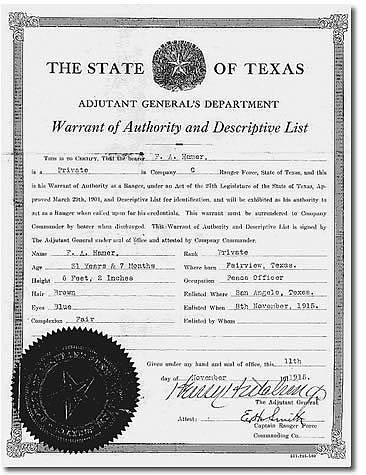
Frank Hamer's 1915 Warrant of Authority © 1999
The Texas Ranger Hall of Fame and Museum |
When
the Frontier Battalion and Special Force were formed in 1874, it was difficult
for Texas Rangers to establish their authority. The State of Texas Adjutant
General's Office began issuing Warrants of Authority -- impressive paper
documents kept folded in their pockets -- to officers but not to enlisted
men.
This
practice continued, in one form or another, until 1935 when badges and
credentials were specified for all Texas Rangers.
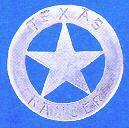 |
Earliest Authenticated Texas Ranger Badge
circa 1889 |
The
first Texas Ranger badges were made for individual Rangers from Mexican
coins at their request. Some were probably made by jewelers, others may
have been made by gunsmiths or metalworkers. The legend of Rangers cutting
them out of coins around campfires is unlikely.
These
first badges were used as a means of identifying Rangers in the midst of
feuds and disputes that might involve several law enforcement agencies,
or where hired guns were introduced. Photographs taken in the 1870s through
the 1920s show that there was a great variety of badges and that comparatively
few Rangers wore badges. |
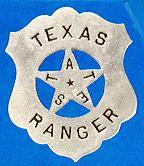 . .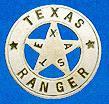 . .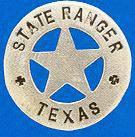
Texas Ranger Badges about 1910-1925 © 1999,
the Texas Ranger Hall of Fame and Museum
| The
"shield" badge worn on the left was carried by "Special" Railroad Ranger
Milton Poole in the 1920s. He had similar authority to regular Texas Rangers,
but was paid by the railroad instead of the state. Shield badges were rarely
worn by Rangers and are rare. The word "State" served to establish a wide
jurisdiction
The
center badge was worn by Ranger D.E. Haines during Prohibition, a small
circle-star or wagon wheel badge with T-E-X-A-S spelled out in the Center.
The word "Texas" served to establish statewide jurisdiction the same way
"State" did on the above badge.
The
badge on the right was worn by Ranger Marvin "Red" Burton. It is believed
to be a "Stock" design sold to law enforcement agents through catalogs |
|
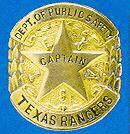 |
Texas Ranger Badge used from 1938-1957
©1997 The Texas Ranger Hall of Fame and Museum
Shortly
after the Texas Rangers were merged with the Department of Public Safety,
a new badge design was issued by the state. Roughly oval-shaped, it contained
the legend "Dept. of Public Safety", the letters T-E-X-A-S and a star with
the rank in the center. Captains were issued gold badges, lower ranks received
silver. |
BADGES WITH HISTORY
Texas Department of Public Safety
1957
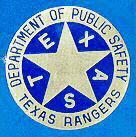
The following article was released by the Texas
Department of Public Safety in 1957 when the Texas Rangers were
issued the above blue badges. They proved to
be very unpopular, and were called the "bottle cap" badges."
| About
the first of July, 1957, members of the Texas Department of Public Safety
donned new badges, marking another milestone in the 134-year--old history
of state law enforcement in Texas.
The
change to the new badge presents a streamlined version of the very first
in badges for state lawmen who find their beginning in the "Texas Rangers
in the year 1823 when Stephen F. Austin appointed 10 "Rangers" to protect
settlers from Indians.
Badges
have been part of the equipment of law enforcement officers for hundreds
of years. They originated in ancient times when the armored knights wore
a insignia to announce their official status and allegiances.
No
one knows exactly how the badge got its start in Texas and little is known
of the type of badge that was first carved from Mexican silver dollars
by Rangers who rode across the southern and western parts of Texas, fighting
Indians and Mexicans.
The
name Rangers was applied to the group selected in 1823 for their chore
of "riding the range" of "ranging about the country" fighting Indians.
The first Rangers were successful in their mission of Indian fighting and
were officially adopted as the law enforcement body for the people of Texas
in 1835. But the Rangers were not to have official badges until 1935.
The
circle-star badge is believed to be related to the adoption of the state
seal. A letter written by Charles B. Stewart in 1835, now in the Texas
State Archives, states that he used a pearl button in the shape of a five-pointed
star to make an impression in wax as the first state seal. This was during
the convention of Texans who met to proclaim their independence from Mexico.
They also sent three men, Sam Houston, John Cameron and John Forbes to
parlay, with the Indians. The impromptu-wax seal created by Stewart, who
served as secretary of the convention, was on their commissions.
As
Stewart stated it in his letter of 1835, the star is "A fitting emblem
of a new star arisen-in the galaxy of states (nations)." Thus, marked the
beginning of a five-pointed star officially accepted in the flag of the
"Lone Star State," and the first state law enforcement badge.
The
new badge of the Texas DPS, placed into service around July 1 (figure 1),
is a modern version of the old Ranger badge with a five-pointed star surrounded
with a royal blue background and silver or gold letters that spell out
TEXAS. The lettering on the outer circle is in royal blue and the background
is gold or silver, depending upon the wearer's rank. |
TEXAS RANGERS NOW WEAR NEW BADGES
OF MEXICAN SILVER
October, 1962 |
|
|
.. |
The following article was released by the Texas Department of Public
Safety in 1962 when the Texas Rangers were issued the current gold and
silver badges.
Colonel
Homer Garrison, Jr., Director of the Texas Department of Public Safety
and Chief of the Texas Rangers, announced in October, .1962, that
the Texas Rangers are going back to the tradition steeped Mexican silver
badge worn by their predecessors during frontier days.
Garrison
said the new official Ranger badge, issued to each of the 62 members of
the Force, is a replica of the historic original badge which old-time Rangers
carved out of a Mexican five peso silver dollar when Texas became a State
and their duties changed from military to law enforcement.
Each
badge is made from a Mexican five Peso silver coin. The oak leaves on the
left side represent strength and the olive branch on the right signifies
peace. These are taken from the Texas Great Seal. The cutout center star. |
| has
engraving on it and the center of the star is reserved for the Company
designation or the rank of Sergeant or Captain or Senior Captain. The edges
still often have the coin lines and the coin is still highly visible on
the reverse of the badge. The five point "Lone Star" with a "wheel" around
it is common in Ranger and other Texas badges from the late 1800's |

Thanks
Again to the Bryon A. Johnson, Director
For
more about the famed Texas Rangers
Visit
their Web Site
click
on their logo
All articles submitted to the "Brimstone
Gazette" are the property of the author, used with their expressed permission.
The Brimstone Pistoleros are not
responsible for any accidents which may occur from use of loading
data, firearms information, or recommendations published on the Brimstone
Pistoleros web site. |
|